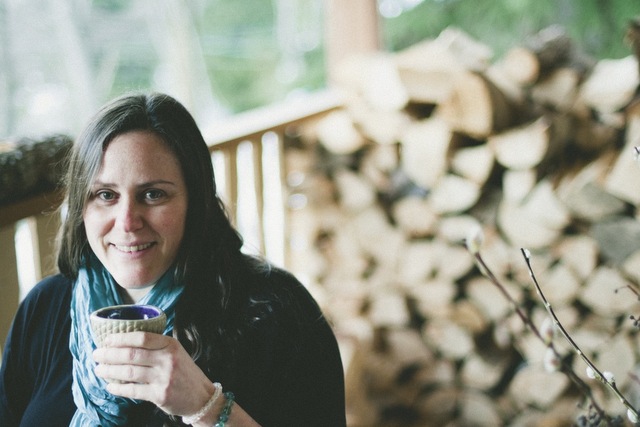The secret to the most perfect cup of tea? We caught up with Isabelle Ranger, the Whistler-based founder of Namasthé Tea Co., to find out…
Tell us a bit about yourself. What should people know?
I love foraging in the BC Coast Mountains for botanicals and fungi that we tea-craft into curated blends for chefs and tea lovers. Our whole family forages: Cédric, my partner, and our three kids – Kalea (15), Samuel (8), and Xavier (3). The kids love trailblazing in the forest scouting for mushrooms, cool spots, sticks and stones. I love exploring possibilities in the forest, on the farm and in tea blending. It is so fun to add tea to distilled spirits, bitters, ferments of all kinds, broths, sauces, rubs and simply tea. I love pure teas as they occur naturally from unique heirloom varietals, skilled tea artisans and seasoned growers. So we never add “natural flavour” to fake aroma. Instead, we use fresh seasonal tisanes and teas expressing the unique ‘thérroir’ of each tea growing region, varietal, season and artisan through all the senses.
ADVERTISEMENT |
What makes Namasthé Tea Co. such a special tea company in your opinion?
We seek ‘thérroir’ botanicals off the beaten path, following the changing seasons that we tea-craft fresh on demand. We make every blend to order with our own organic, farm-grown herbs, our unique foraged botanicals, and premium organic and fair-trade single origin teas. We even began growing camellia sinensis as part of our research and development and to play with Canadian tea.
We are also pushing the envelop with loose leaf tea pouches with these same custom blends to change the stigma associated with lesser quality teas in the grocery aisle tea pouches. We are bringing back the craftsmanship to the once innovative tea pouch. Most often, loose leaf teas end up back in leaky over-sized tea pouches or plastic “silky” ones, so we offer a better solution that is simple, sustainable and delicious. No need to compromise loose leaf quality for practicality.
We are also independent and do everything in-house, which is quite uncommon in the tea world but it gives us more creative possibilities and better quality control – but it is also a lot more work than just rebagging some generic blends commonly available. We have to plan to forage for the year’s needs so some botanicals are seasonal and sell out. Same for our special farm grown herbals. If we run out, many of them are not available anywhere so gauging needs is always crucial. We have many tea companies who call us to buy our locally grown botanicals, but at this time we only grow for Namasthé Teas. It is all work, but the rewarding freshness, taste and aroma are unbeatable.
You’re a certified herbalist. What does that mean and how did you become one?
I studied as a consultant herbalist at Langara College with shamanic herbalist Don Ollsin. He was taught by Elder Ellen White on Vancouver Island and also by renowned UK Medical Phytotherapist Rowan Hamilton, who teaches naturopaths at Bastyr and the Boucher Institute. We learned to respect, identify and sustainably forage botanicals the First Nations way. We learn to craft tinctures, salves, oils in basic formulas along with pathophysiology and consulting practices. Much of my experience came from opening an herbal apothecary co-op with other women.
ADVERTISEMENT |
What are some of your favourite teas for their health benefits?
The simple weeds are my favourites and we grow many weeds at the farm on purpose, so when we weed at the farm we use some of them. By far burdock, wild roses, rosehips, yellow dock, nettles, chicory, dandelion, poplar bud, Labrador tea, douglas fir, reishi, matsutake, turkey tails and juniper are some of my all time faves, but I love them all – even the most bitter like gentian. We are going to grow some gentian this year for some bitters tea blend for local mixologists. One of our special farm-grown herbs is tulsi (holy basil), and it is so euphorically sweet and pungent as well as a prime pollinator. Our lemon verbena is divinely lemon honey-sweet. One that is really great is rhodiola, an adaptogen that helps cope with mental and physical stress and it graces many of our fine blends. How can I possibly love one more than another?!
And what are some of your favourite teas for their flavours?
Most of all, oolongs with pit fruit, orchid, tropical fruit, raisin or muscatel notes are always favourites for slow tea sessions with a gaiwan on the home TBar. Eastern beauty, ali shan, and da yu lin oolongs are my relaxing teas to sip slowly with Cédric. This year we are adding some amazing Nepali teas from Jun Chiyabari Tea Gardens that we absolutely love both for their aroma and taste as well as their philosophy to empower women growers/pickers. Ancient heirloom tea trees have always had a special place in my heart and puerhs are the only fermented teas that are aged and collected. Our 2005 sheng puerh tuo cha is a white buds raw puerh with amazing pit fruit notes balanced with earthy tones. Our Earl Grey from ancient tree tea, and our Calabrian organic bergamot cold-pressed oil with our hand-plucked cornflowers from our TPatch in Pemberton is a staple we cant live without.
What are three things you can’t live without?
My family, food, and tea; but I must add learning as it fuels me every day!
How do we stay up-to-date with you?
Twitter, Facebook, Instagram and namasthe.ca. We love to share about adventures, weeding, food and tea crafting.







